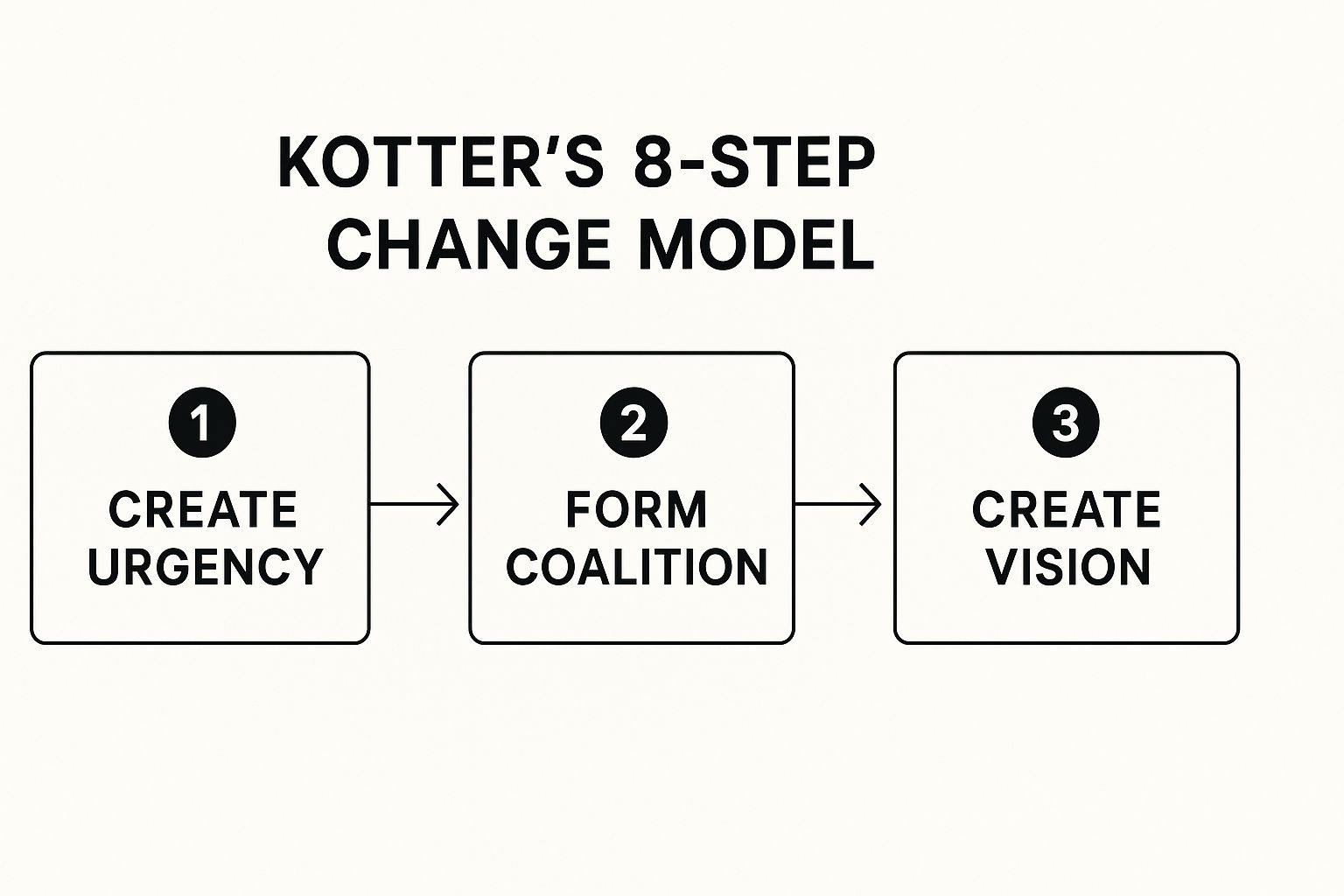Navigating Change in the Modern Business Landscape
Constant change is a reality for modern businesses. To thrive, organizations must adapt effectively. This listicle presents seven prominent organizational change models to guide you through successful transformations. Learn about Kotter's 8-Step model, Lewin's model, ADKAR, McKinsey 7-S, Bridges' Transition model, the Kübler-Ross Change Curve, and Nudge Theory. Master these models to lead change initiatives, minimize disruption, and create a thriving future for your organization. Consider enhancing your HR skills with a relevant certification from Global Human Resource Institute.
1. Kotter's 8-Step Change Model
Navigating organizational change can feel like charting a course through uncharted waters. But with the right map, the journey becomes much more manageable. Kotter's 8-Step Change Model, developed by Harvard Business School professor John Kotter, provides precisely that – a structured, easy-to-follow framework for successfully implementing lasting organizational change. Based on Kotter's observations of over 100 organizations undergoing transformations, this model emphasizes the crucial role of leadership in preparing, guiding, and anchoring change within the organizational culture. It offers a powerful roadmap for any organization seeking to evolve and thrive.

This infographic visually represents the flow of Kotter's 8-Step Change Model, highlighting the sequential progression through each stage, from creating a sense of urgency to ultimately anchoring the new changes within the company culture. The interconnectedness of the steps underscores the importance of building momentum and maintaining focus throughout the entire change process.
The model’s strength lies in its sequential approach, outlining eight distinct phases:
-
Create Urgency: Inspire a sense of necessity and urgency for change within the organization.
-
Form a Powerful Coalition: Assemble a guiding coalition of influential individuals across various levels of the organization.
-
Create a Vision for Change: Develop a clear and compelling vision to direct the change effort and strategies for achieving it.
-
Communicate the Vision: Effectively communicate the vision and strategies across the organization, ensuring everyone understands the "why" behind the change.
-
Remove Obstacles: Identify and remove obstacles that hinder the change process, empowering employees to embrace and contribute to the change.
-
Generate Short-Term Wins: Create and celebrate visible, unambiguous short-term wins to demonstrate progress and maintain momentum.
-
Consolidate Gains and Produce More Change: Build on early successes to tackle bigger challenges and expand the scope of change.
-
Anchor New Approaches in the Culture: Embed the new changes within the organizational culture to ensure long-term sustainability.
Kotter's model has proven invaluable in diverse organizational settings. British Airways utilized it during its transition from a government entity to a customer-centric private company. Siemens AG implemented it during major restructuring initiatives. Even tech giants like Microsoft leveraged this approach for cultural transformation under Satya Nadella. These examples highlight the model's versatility and effectiveness across industries and scales.
When and Why to Use Kotter's Model:
This model excels in situations where significant, organization-wide change is required. Its structured approach provides a clear path forward, mitigating chaos and resistance. It's particularly well-suited for top-down change initiatives led by strong leadership teams.
Pros:
- Structured Framework: Offers a clear, step-by-step process, making complex change more manageable.
- Emphasis on Preparation: Recognizes the importance of laying the groundwork for change before implementation.
- Holistic Approach: Addresses both the emotional and situational aspects of organizational change.
- Sustainable Change: Focuses on embedding change within the organizational culture for long-term impact.
Cons:
- Linearity: The linear approach may not fully capture the nuances and complexities of real-world change scenarios.
- Time-Consuming: Implementing all eight steps can be time-intensive, potentially unsuitable for organizations requiring rapid change.
- Top-Down Focus: Primarily emphasizes top-down implementation, potentially overlooking valuable bottom-up initiatives.
Actionable Tips for Success:
- Don't Rush the Early Stages: Invest sufficient time and effort in building urgency and forming a strong coalition.
- Broaden Your Coalition: Involve influential individuals from various levels and departments to foster organization-wide buy-in.
- Celebrate Short-Term Wins: Ensure short-term wins are visible, unambiguous, and directly linked to the change effort.
- Communicate Consistently: Regularly communicate how the changes are positively impacting performance and contributing to overall success.
Kotter's 8-Step Change Model deserves a prominent place on any list of organizational change models due to its comprehensive and structured nature. It provides a practical roadmap for leaders navigating complex transformations, empowering them to drive meaningful and lasting change. By focusing on preparing the organization, building momentum through visible wins, and anchoring changes in the culture, Kotter's model sets the stage for sustainable growth and success in a dynamic environment.
2. Lewin's Change Management Model
Kurt Lewin's Change Management Model is a cornerstone of organizational change theory, providing a simple yet powerful framework for understanding and implementing change within any organization. This three-stage model, developed by renowned social psychologist Kurt Lewin, conceptualizes change as a process of "Unfreeze," "Change (or Move)," and "Refreeze." It emphasizes the importance of preparing for change, managing the transition, and solidifying the new state to ensure lasting impact. This model earns its place on this list due to its enduring relevance and widespread applicability across diverse industries and organizational contexts. Its intuitive nature makes it easy to grasp for anyone involved in leading or navigating change.

How it Works:
-
Unfreeze: This initial stage focuses on dismantling the existing status quo and creating a readiness for change. It involves breaking down existing mindsets and behaviors, communicating the need for change, and creating a sense of urgency. This often requires addressing resistance and fostering a psychologically safe environment where individuals feel empowered to embrace the upcoming transition.
-
Change (or Move): This is the transitional phase where the actual change is implemented. It's a period of uncertainty and potential discomfort as individuals learn new behaviors, processes, and ways of working. Clear communication, training, and support are crucial during this stage to guide individuals through the transition and minimize disruption.
-
Refreeze: The final stage focuses on solidifying the new state and embedding the changes within the organizational culture. This involves reinforcing new behaviors through systems, policies, and rewards. The aim is to create stability and prevent regression to old habits, ensuring the changes become the new norm.
Features and Benefits:
- Three clear phases: Provides a structured approach to managing change, making it easier to plan and execute.
- Focus on psychological aspects: Recognizes the human element of change and addresses resistance, fostering buy-in.
- Force Field Analysis: Offers a tool to identify driving and restraining forces impacting change, enabling targeted interventions.
- Emphasis on creating psychological safety: Facilitates a supportive environment where individuals feel comfortable embracing change.
Pros:
- Simple and easy to understand: Accessible to all levels of the organization.
- Process-oriented: Recognizes change as a journey rather than a one-time event.
- Proactive approach: Emphasizes preparing for change before implementation.
- Focus on stabilization: Ensures long-term sustainability of change initiatives.
Cons:
- Oversimplification: May not capture the full complexity of change in dynamic environments.
- Assumption of stability: The "refreezing" concept may not be suitable for today's rapidly evolving business landscape.
- Limited practical guidance: Provides a high-level framework but lacks detailed implementation tactics.
Examples of Successful Implementation:
- Shell Oil: Utilized Lewin's model for major structural and cultural transformations.
- Healthcare organizations: Implemented new patient care protocols.
- Educational institutions: Implemented curriculum changes.
Tips for Implementation:
- Unfreeze: Clearly articulate the reasons for change, address concerns, and create a sense of urgency. Conduct a Force Field Analysis to identify and mitigate resistance.
- Change: Provide clear communication, training, and support to guide individuals through the transition.
- Refreeze: Update systems, policies, and rewards to reinforce the new ways of working. Consider ongoing reinforcement and adaptation in dynamic environments.
When and Why to Use This Approach:
Lewin's model is particularly valuable when implementing fundamental changes that require a shift in mindsets and behaviors. It's suitable for a wide range of organizational change initiatives, from restructuring and cultural transformation to process improvements and technology adoption. While the "refreeze" stage might require adaptation in constantly evolving environments, the core principles of unfreezing and managing the transition remain highly relevant for navigating change effectively. This model is a valuable tool for aspiring HR professionals, experienced HR specialists, educational institutions, corporate HR teams, and the global HR community. It empowers them to lead change initiatives strategically and achieve lasting organizational improvements.
3. ADKAR Change Management Model
The ADKAR Change Management Model stands out among organizational change models for its laser focus on the individual. Developed by Prosci founder Jeff Hiatt, this powerful framework emphasizes that successful organizational change happens one person at a time. Instead of viewing change as a top-down initiative, ADKAR recognizes that true transformation occurs when each individual successfully navigates the change process. This makes it an invaluable tool for aspiring HR professionals, experienced HR specialists, educational institutions, corporate HR teams, and the global HR community alike.
How ADKAR Works:
ADKAR is built upon five sequential building blocks, each representing a crucial milestone in an individual's journey through change:
- Awareness: Understanding the why behind the change. This is the foundational step, ensuring individuals comprehend the necessity and nature of the change.
- Desire: The motivation and willingness to support and participate in the change. This stage addresses the emotional aspect of change, fostering a positive attitude and commitment.
- Knowledge: Acquiring the information and skills necessary to implement the change effectively. This involves providing training, resources, and support to equip individuals with the practical know-how.
- Ability: Demonstrating the capability to implement the change in their day-to-day work. This goes beyond simply possessing knowledge; it focuses on the actual application and performance in the changed environment.
- Reinforcement: Sustaining the change over time through ongoing support, feedback, and recognition. This crucial step prevents regression and ensures the change becomes embedded in the organizational culture.
Why ADKAR Deserves Its Place:
ADKAR's strength lies in its practicality and actionable nature. Its individual-focused approach, coupled with practical assessment tools, allows for targeted interventions at each stage. This helps identify and address roadblocks before they derail the entire change initiative. Unlike organizational change models that focus on broad strategies, ADKAR provides a clear roadmap for navigating the human side of change, making it particularly effective for complex transformations.
Pros:
- Highly practical and actionable: Provides concrete steps and tools to guide individuals through change.
- Clear guidance: Offers a structured framework for change management activities.
- Easy integration: Aligns seamlessly with project management approaches.
- Targeted interventions: Allows for personalized support based on individual needs.
Cons:
- Resource intensive: Can require significant resources, especially in large organizations.
- Limited systemic focus: Less emphasis on broader organizational culture and systems.
- Sequential limitations: May not always reflect the non-linear reality of individual change experiences.
- Team dynamics: Limited consideration of team dynamics within the change process.
Successful Implementations:
- General Motors: Utilized ADKAR to guide its massive reorganization following bankruptcy, helping individuals navigate significant changes in roles and responsibilities.
- Colorado Housing and Finance Authority: Successfully applied ADKAR for a technology implementation, ensuring employees adopted and effectively used the new systems.
- Nordstrom: Leveraged ADKAR to transform its customer service model, empowering employees to deliver an enhanced customer experience.
Actionable Tips for Using ADKAR:
- Impact Assessments: Identify who will be affected by the change and how.
- Targeted Communication: Develop tailored communication plans to build awareness and desire.
- Personalized Approaches: Address individual concerns and motivations.
- Progress Tracking: Use surveys and assessments to monitor progress through the ADKAR stages.
- Leadership Alignment: Ensure leadership messages and actions support each ADKAR element.
When and Why to Use ADKAR:
ADKAR is particularly valuable when:
- Implementing significant organizational changes affecting individual roles and responsibilities.
- Introducing new technologies or processes requiring employee adoption and skill development.
- Transforming organizational culture or customer service models.
- Managing change in complex environments with diverse employee populations.
By focusing on the individual experience, ADKAR offers a powerful framework for navigating the human side of change and driving successful organizational transformations. While (currently) no specific website link is available for ADKAR itself, searching for "Prosci ADKAR" will provide ample resources and information. By embracing the ADKAR principles, organizations can empower their people to embrace change, leading to greater success and a more positive transition experience for everyone involved.
4. McKinsey 7-S Model
Navigating organizational change can feel like charting a course through uncharted waters. The McKinsey 7-S Model offers a powerful compass and map for this journey, providing a holistic approach to understanding and implementing effective transformations. Developed by McKinsey consultants Tom Peters and Robert Waterman, this model helps organizations diagnose their current state and chart a course towards a more aligned and successful future. It posits that organizational effectiveness isn't just about strategy and structure, but a complex interplay of seven interconnected elements.

The 7-S Model encompasses three "hard" elements – Strategy, Structure, and Systems – and four "soft" elements – Shared Values, Skills, Style, and Staff. These elements are visualized as interconnected points, emphasizing their interdependence. At the core of the model lie Shared Values (also referred to as Superordinate Goals), acting as the central guiding force influencing all other elements.
How it Works: The 7-S Model functions as a diagnostic tool, enabling organizations to assess the alignment between these seven key elements. By analyzing each element individually and in relation to others, you can pinpoint inconsistencies and areas that require attention. For instance, a change in strategy might necessitate adjustments to the organizational structure, systems, and even the skills required by staff. The model highlights the importance of considering the ripple effect of any change initiative across the entire organization.
Successful Implementations: The 7-S Model has been instrumental in driving successful transformations across diverse industries. IBM leveraged the framework during its significant restructuring under Lou Gerstner, while Coca-Cola utilized it for reorganizing global operations. JPMorgan Chase also found the model invaluable during merger integration activities. These examples underscore the model's adaptability and effectiveness in complex organizational change scenarios.
Actionable Tips for Using the 7-S Model:
- Start with a Thorough Assessment: Analyze the current state of each of the seven elements. Gather data through surveys, interviews, and observation.
- Identify Gaps and Inconsistencies: Pinpoint areas where misalignment exists and prioritize areas needing adjustment.
- Consider Interdependencies: Analyze how changes in one element will cascade and affect others.
- Prioritize the "Soft" Elements: Don't underestimate the power of Shared Values, Skills, Style, and Staff. These elements are often crucial for successful change, influencing employee buy-in and driving overall effectiveness.
- Regularly Reassess Alignment: As implementation progresses, continue to monitor and reassess the alignment of the seven elements, making adjustments as needed.
When and Why to Use the 7-S Model: This model is particularly valuable when:
- Implementing a new strategy: Ensure all elements support the strategic direction.
- Managing mergers and acquisitions: Integrate different organizational cultures and structures.
- Improving organizational performance: Identify and address weaknesses hindering effectiveness.
- Implementing significant organizational change: Navigate complex transformations smoothly.
Pros:
- Comprehensive perspective beyond structure and strategy.
- Recognition of both formal and informal organizational aspects.
- Useful for understanding the ripple effects of change.
- Effective diagnostic tool.
Cons:
- Complex implementation due to interdependencies.
- Limited focus on external environmental factors.
- Difficulty in measuring "soft" elements.
- Lack of specific implementation steps.
The McKinsey 7-S Model deserves its place on this list of organizational change models because it provides a comprehensive and insightful framework. By understanding and applying the principles of this model, aspiring HR professionals, experienced specialists, educational institutions, corporate HR teams, and the global HR community can lead and manage organizational change with greater confidence and success. It empowers organizations to move beyond surface-level changes and address the deeper, interconnected factors that drive true transformation.
5. Bridges' Transition Model: Navigating the Human Side of Change
Organizational change models often focus on the what and how of change, but Bridges' Transition Model delves into the often-overlooked who: the people experiencing the change. This model recognizes that true organizational change isn't simply about shifting structures or processes; it's about guiding individuals through the complex emotional journey that accompanies any significant shift. This focus on the human element makes it a crucial model for any HR professional, corporate team, or educational institution seeking to implement change effectively. It’s precisely this people-centric approach that earns Bridges' Transition Model a well-deserved spot on this list of essential organizational change models.
Unlike models that focus on the external process of change, Bridges' emphasizes transition, which is the internal psychological process people undergo as they adjust to change. This model distinguishes between change (the external event) and transition (the internal reorientation). It highlights the importance of understanding and supporting employees through the emotional ups and downs inherent in any transformation.
How It Works: The Three Phases of Transition
Bridges' model outlines three distinct phases that individuals typically experience during a transition:
-
Ending/Losing/Letting Go: This phase is marked by feelings of loss, anxiety, denial, confusion, and even anger. Individuals are letting go of old ways of working, familiar processes, and established relationships. It’s a crucial stage where acknowledging the past and allowing space for grief and frustration is essential.
-
The Neutral Zone: Often described as a "fallow period," the Neutral Zone can feel disorienting and uncertain. However, it's also a fertile ground for creativity and innovation. As individuals begin to let go of the past and haven’t fully embraced the future, new ideas and perspectives can emerge. This phase requires strong leadership and support to help individuals navigate the ambiguity and harness the potential for growth.
-
The New Beginning: This phase marks the acceptance of the new reality and a renewed sense of purpose and energy. Individuals embrace new roles, processes, and relationships, leading to increased productivity, engagement, and commitment. Celebrating successes and reinforcing the positive aspects of the change are vital in solidifying this new beginning.
Successful Implementations:
Bridges' Transition Model has been successfully implemented by numerous organizations navigating significant change:
- Hewlett-Packard leveraged the model during its complex merger with Compaq, helping employees navigate the uncertainty and cultural shifts.
- Providence Health & Services applied the model during healthcare reform transitions, enabling staff to adapt to new regulations and processes.
- Adobe incorporated the model during its transition to a subscription business model, supporting employees through the significant changes in sales, marketing, and customer service.
Actionable Tips for Implementation:
- Acknowledge and honor the ending: Hold rituals or ceremonies to mark the transition and validate the feelings of loss.
- Support the Neutral Zone: Create temporary structures, provide clear communication, and foster open dialogue to help individuals navigate uncertainty.
- Be patient and empathetic: Recognize that transitions take time and that emotional responses are natural.
- Celebrate new beginnings: Reinforce successes and highlight the positive aspects of the change.
- Communicate consistently: Keep employees informed throughout the transition process, addressing what's ending, what remains, and what's new.
Pros and Cons:
Pros:
- Addresses the human emotional response to change.
- Provides guidance for supporting individuals through transitions.
- Recognizes that different people transition at different rates.
- Helps leaders understand resistance as a natural part of the process.
Cons:
- Less focused on the practical/structural aspects of change.
- May require significant time investments.
- Requires skilled leadership with high emotional intelligence.
- Can be challenging to align individual transitions with organizational timelines.
By focusing on the human side of change, Bridges' Transition Model provides a valuable framework for navigating organizational transformations successfully. It empowers leaders to support their teams through the emotional journey, ultimately fostering a smoother, more positive, and ultimately more effective change process. This model is a crucial tool for aspiring and experienced HR professionals, corporate HR teams, educational institutions, and the global HR community at large, enabling them to lead with empathy and guide their organizations towards a brighter future.
6. Kübler-Ross Change Curve
Navigating the often turbulent waters of organizational change can feel like an emotional rollercoaster. The Kübler-Ross Change Curve, adapted from Elisabeth Kübler-Ross's groundbreaking work on the stages of grief, provides a valuable framework for understanding and managing the human side of transitions within organizations. This model deserves its place on this list of organizational change models because it offers crucial insights into the psychological impact change has on individuals, empowering leaders to guide their teams through the process with empathy and support.
This model maps the emotional journey individuals typically experience when confronted with significant change. It posits that people move through a series of stages: shock, denial, anger, bargaining, depression, testing, and finally, acceptance. While not strictly linear, this framework illustrates the emotional ebb and flow that often accompanies change, reminding us that negative reactions are a normal part of the process. Visualizing this journey as a curve, often with performance/morale plotted against time, highlights how productivity can dip during the transition before eventually rising again.
How it Works: The Kübler-Ross Change Curve emphasizes that emotional responses significantly impact how individuals adapt to change. By understanding these stages, leaders can anticipate potential reactions, tailor their communication strategies, and provide appropriate support at each phase.
Features and Benefits:
- Emotional Stages: Recognizing the distinct emotional stages (shock, denial, anger, bargaining, depression, testing, acceptance) allows for proactive intervention and support.
- Focus on Psychological Responses: This model prioritizes the human element of change, reminding us that change is not just about processes and systems, but also about people.
- Visual Representation: The curve visually depicts the emotional and performance trajectory, making it easy to understand and communicate.
- Improved Understanding and Empathy: By normalizing negative emotions, the model fosters greater understanding and empathy within teams.
Pros:
- Helps leaders anticipate and understand emotional responses.
- Normalizes negative reactions as part of the change process.
- Provides insight into why productivity often dips during transitions.
- Simple framework that resonates with most people’s experiences.
Cons:
- Originally developed for grief situations, not specifically organizational change.
- Individuals may not experience stages in the prescribed order or intensity.
- Doesn't provide specific organizational change implementation tactics.
- May overemphasize negative emotional responses.
Examples of Successful Implementation:
- Microsoft: Utilized the framework during major reorganizations to support employees through the transition.
- Healthcare Organizations: Applied the model during mergers and acquisitions to address emotional impacts on staff.
- Educational Institutions: Referenced the curve during curriculum overhauls to guide faculty and students.
- Government Agencies: Utilized the model during policy implementation changes to understand public reaction.
Actionable Tips for Implementation:
- Train Managers: Equip managers to recognize and address the emotional responses within their teams.
- Targeted Support: Provide additional support resources, such as counseling or coaching, during the 'depression' phase.
- Patience and Empathy: Avoid rushing individuals through the emotional process; allow them the time they need to adjust.
- Transparent Communication: Use clear and consistent communication to minimize uncertainty and build trust.
- Celebrate Milestones: Acknowledge and celebrate progress when individuals reach the 'acceptance' stage to reinforce positive momentum.
When and Why to Use This Approach: The Kübler-Ross Change Curve is particularly valuable when implementing significant organizational changes that are likely to have a substantial emotional impact on employees. It's a powerful tool for building empathy, managing expectations, and fostering a supportive environment during times of transition.
Popularized By: Elisabeth Kübler-Ross's seminal work, On Death and Dying, provided the foundation for this model, which has since been adapted and widely adopted by change management practitioners.
By acknowledging and addressing the emotional aspects of change using the Kübler-Ross Change Curve, organizations can create a smoother, more human-centered transition, ultimately leading to greater success and employee well-being.
7. Nudge Theory: Inspiring Change Through Gentle Guidance
Nudge Theory offers a fresh and inspiring approach to organizational change, leveraging the power of behavioral economics to guide individuals towards desired outcomes without restricting their freedom of choice. This innovative model recognizes that even small, subtle changes in the environment or processes can significantly influence behavior and contribute to meaningful organizational shifts. As such, it deserves a prominent place amongst effective organizational change models, providing a powerful alternative to traditional, often more forceful, methods. This approach is particularly valuable for aspiring HR professionals, experienced HR specialists, educational institutions, corporate HR teams, and the global HR community seeking to implement positive change within their organizations.
How Nudge Theory Works:
Instead of mandating change through directives or policies, Nudge Theory focuses on "choice architecture"—the way choices are presented. By subtly altering the context in which decisions are made, it becomes possible to encourage specific behaviors without limiting options. This respects individual autonomy and promotes a sense of ownership over the change process. The theory relies on understanding the psychological principles that influence decision-making, such as defaults, social proof, and framing.
Features and Benefits:
- Subtle Interventions: Nudges are gentle guides, not forceful directives, fostering a more receptive environment for change.
- Choice Architecture Focus: Nudge Theory emphasizes the importance of how choices are presented, recognizing that subtle adjustments can have a profound impact.
- Behavioral Economics Principles: It leverages psychological insights to design interventions that resonate with human decision-making processes.
- Preservation of Freedom: Individuals retain their autonomy and the power to choose, promoting a sense of ownership and buy-in.
Examples of Nudge Theory in Action:
- Google's Healthy Eating Nudges: By strategically placing healthier food options in more visible and accessible locations in their cafeterias, Google encouraged employees to make healthier choices without restricting access to other options.
- UK Government's Behavioural Insights Team: This team successfully used nudges to improve tax collection rates by simply rewording letters to emphasize social norms and the majority's compliance.
- Walmart's Wellness Program Nudges: Nudges were implemented to encourage higher participation rates in employee wellness programs, leading to improved health outcomes.
- Virgin Atlantic's Fuel Efficiency Nudges: By providing pilots with real-time feedback on their fuel consumption and highlighting best practices, Virgin Atlantic successfully reduced fuel usage without imposing strict regulations.
Actionable Tips for Implementing Nudge Theory:
- Default to Desired Behaviors: Make the preferred option the default choice whenever possible. This reduces the effort required for positive change.
- Leverage Social Proof: Highlight the adoption of desired behaviors by respected colleagues or peers to encourage wider acceptance.
- Reduce Friction for Desired Behaviors: Streamline processes and remove obstacles for positive choices while introducing minor inconveniences for undesired ones.
- Test and Iterate: Implement nudges on a small scale before widespread adoption to assess their effectiveness and refine strategies.
- Transparency is Key: Maintain trust by being open about the use of nudges and their intended purpose.
- Cultural Sensitivity: Tailor interventions to specific cultural contexts to ensure they are well-received and effective.
Pros and Cons:
Pros:
- Reduced Resistance: Nudges often encounter less resistance than mandated changes.
- Cost-Effective: Implementation can be relatively inexpensive compared to other change management approaches.
- Respects Autonomy: Individuals maintain freedom of choice.
- Significant Impact: Small interventions can lead to surprisingly significant results.
- Adaptability: Nudge Theory can be adapted to various organizational contexts and cultures.
Cons:
- Modest Effects (Sometimes): Effects may be smaller than those achieved through direct mandates.
- Requires Behavioral Expertise: Successful implementation requires a good understanding of behavioral psychology.
- Careful Design is Crucial: Effectiveness depends on meticulous design and testing.
- Ethical Considerations: Concerns about potential manipulation need to be addressed.
- Difficult Measurement: Precisely measuring the impact of nudges can be challenging.
Why Nudge Theory Deserves Its Place:
In a world where top-down mandates often meet with resistance and generate resentment, Nudge Theory offers a refreshing and effective alternative. By respecting individual autonomy and leveraging the power of behavioral insights, it empowers organizations to achieve meaningful change through gentle guidance and positive reinforcement. This approach is particularly valuable in today's complex and ever-evolving organizational landscape, offering a sustainable and human-centered path to progress. It empowers individuals to embrace change willingly, leading to more successful and sustainable organizational transformations. Popularized by Richard Thaler and Cass Sunstein in their influential book Nudge, and further championed by the Behavioural Insights Team in the UK, this model is gaining traction worldwide for its unique and effective approach.
7 Key Organizational Change Models Compared
| Model | 🔄 Implementation Complexity | ⚡ Resource Requirements | 📊 Expected Outcomes | 💡 Ideal Use Cases | ⭐ Key Advantages |
|---|---|---|---|---|---|
| Kotter's 8-Step Change Model | Moderate to High – Sequential and comprehensive steps | Moderate to High – Leadership involvement needed | Long-term sustainable change with cultural embedding | Large-scale transformations needing structured approach | Structured, momentum-building, prepares organization |
| Lewin's Change Management Model | Low to Moderate – Simple 3 phases | Low to Moderate – Focus on preparation and stabilization | Stable transitions with psychological safety | Organizations seeking clear, simple change processes | Easy to understand, balances emotional & practical |
| ADKAR Change Management Model | Moderate – Sequential individual-focused steps | Moderate to High – Individual assessments & interventions | Effective individual adoption of change | Changes requiring individual behavior adoption | Practical, actionable at individual level |
| McKinsey 7-S Model | High – Complex alignment of 7 interrelated elements | High – Requires cross-department coordination | Holistic organizational alignment and coherence | Diagnosing and realigning complex organizations | Comprehensive, considers hard & soft elements |
| Bridges' Transition Model | Moderate – Focus on people’s psychological phases | Moderate – High emotional support & leadership | Improved emotional adjustment and reduced resistance | Changes with significant emotional impact | Emphasizes psychological transition, manages resistance |
| Kübler-Ross Change Curve | Low to Moderate – Understanding emotional stages | Low to Moderate – Manager training & support | Anticipation and management of emotional responses | Organizations focused on supporting affected individuals | Normalizes emotions, simple, improves leader empathy |
| Nudge Theory | Low to Moderate – Subtle behavioral interventions | Low to Moderate – Design & testing behavioral cues | Behavioral shifts with minimal resistance | Changes benefiting from subtle influence & choice design | Low-cost, respects autonomy, effective small interventions |
Choosing the Right Model for Your Organization
Navigating organizational change can feel like charting unknown waters. This article has explored several powerful organizational change models, from Kotter's 8-Step model to the more nuanced Nudge Theory, each offering a unique framework for understanding and managing transitions. Key takeaways include recognizing the importance of clear communication, fostering a sense of urgency, and addressing resistance throughout the change process. Remember, no single approach fits every scenario. Whether you’re implementing a small-scale process improvement or a complete organizational overhaul, the success of your initiative hinges on selecting the right organizational change model.
When implementing any of these models, it's essential to approach change strategically. The interplay between leadership and change management is crucial for achieving desired outcomes. Learn more about how a leader and change effectively to maximize organizational success from Kirke Leadership. Factors like the scale of the change, your organizational culture, and the resources at your disposal all play a vital role in determining the most effective model. By carefully considering these elements, you equip your organization with the tools it needs not just to survive change, but to thrive in it. Mastering these organizational change models empowers you to lead with confidence, build resilience, and unlock the full potential of your organization's future.
Ready to deepen your understanding of organizational change models and best practices? Global Human Resource Institute provides comprehensive resources and certification programs specifically designed to enhance your change management expertise. Visit the Global Human Resource Institute to explore their offerings and empower your organization to navigate change successfully.




0 Comments